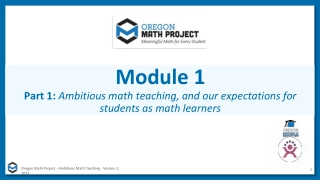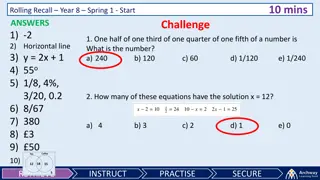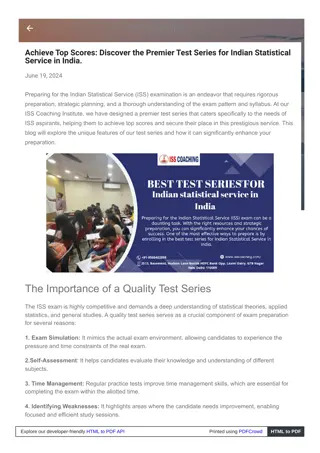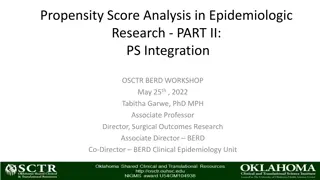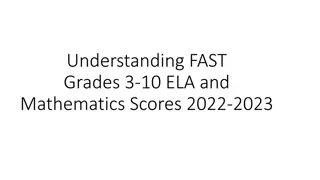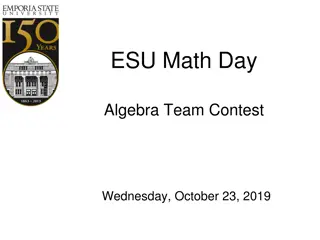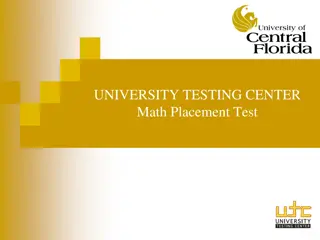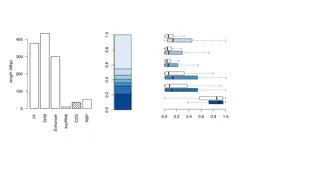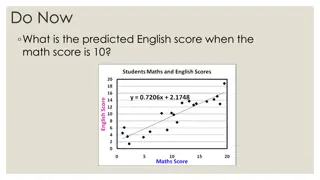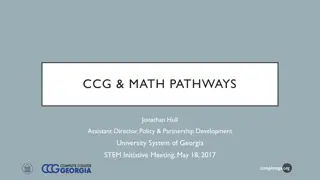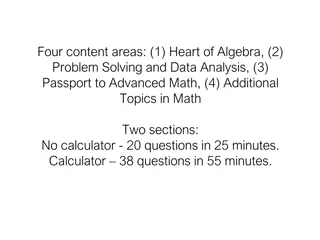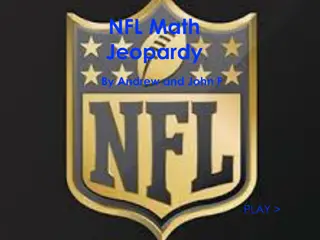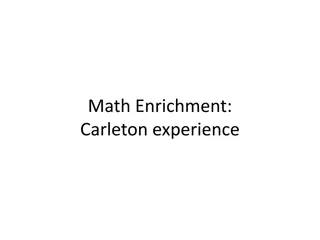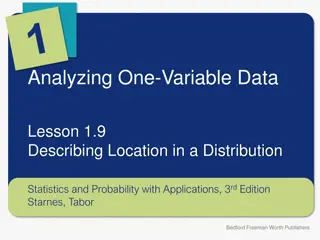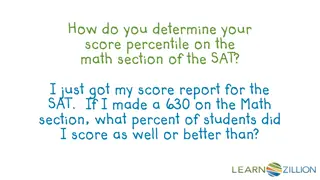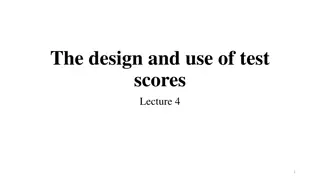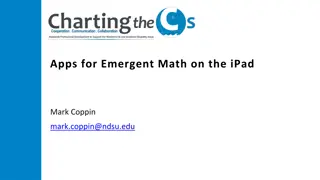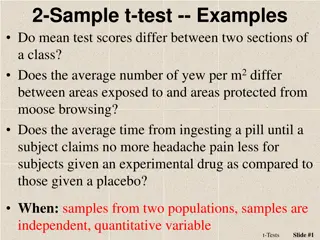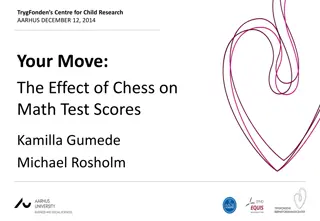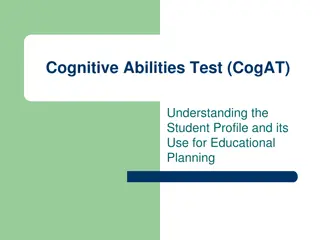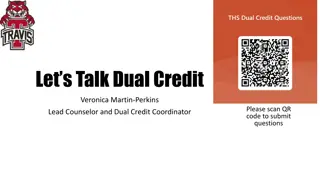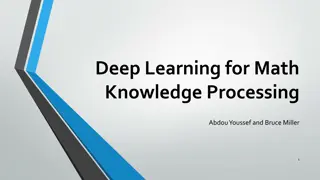Ambitious Math Teaching and Expectations for Students as Learners
Reflect on expectations for students as math learners and explore ambitious math teaching practices. Join the Oregon Math Project to promote equitable math experiences for all students.
0 views • 106 slides
Principles and Practices of Ambitious Math Teaching Oregon Math Project
Explore the ambitious math teaching principles and practices outlined in the Oregon Math Project, focusing on sustaining ambitious math teaching through effective planning, teaching, and assessment strategies. Discover how to value and build on students' mathematical strengths to promote equitable o
0 views • 120 slides
Ambitious Math Teaching at Unit Level - Session 10 Agenda
In Session 10 of the Oregon Math Project, educators focus on engaging students in rich grade-level content through ambitious math teaching. The agenda includes setting norms, collaborative math activities, connecting to research, and planning classroom implementation. Emphasis is placed on supportin
0 views • 89 slides
Year 8 Spring Math Challenge: Test Your Skills in 10 Minutes!
Test your math skills with these challenging questions from a Year 8 Spring math challenge. From solving equations to geometry problems, these interactive challenges will help you sharpen your math abilities in just 10 minutes at a time. Get ready to push your math knowledge to the limit and see how
0 views • 3 slides
Elevate Your ISS Scores: Top Test Series Choices
Boost your Indian Statistical Service (ISS) exam preparation with the best test series for ISS in India. Our curated selection of top test series is designed to enhance your understanding, improve time management, and identify areas for improvement. With expertly crafted questions and detailed perfo
0 views • 3 slides
Understanding the Challenges of Learning Math
Exploring the reasons why math can be perceived as tough, this study skills resource delves into the analogy of math being like a foreign language and a skill that requires practice. It compares high school and college approaches to math education and dispels common myths, emphasizing that everyone
1 views • 12 slides
Effective Strategies for Overcoming Test Anxiety
Learn practical methods to combat test anxiety in this 1-hour workshop by CCAMPIS Kayla Taylor. Topics covered include avoiding test anxiety, preparing effectively for tests, identifying and reducing sources of anxiety, quelling anxiety, test-taking strategies, and stress management. The PASS method
1 views • 13 slides
Understanding iReady Scores and Their Significance for Your Child
iReady scores play a crucial role in identifying your child's strengths and weaknesses in reading and math. This presentation explains what iReady is, how to access the scores in HAC, and what the numbers mean in terms of scale scores and grade level expectations. By understanding these scores, pare
0 views • 10 slides
Understanding Software Testing: Test Cases, Selection, and Execution
Software testing plays a crucial role in identifying and resolving issues within software products. Test cases, selection, and execution are fundamental aspects of the testing process. Test cases define conditions for testing software functionality, with a focus on repeatability and data specificity
2 views • 36 slides
Integration Approaches of Propensity Scores in Epidemiologic Research
Propensity scores play a crucial role in epidemiologic research by helping address confounding variables. They can be integrated into analysis in various ways, such as through regression adjustment, stratification, matching, and inverse probability of treatment weights. Each integration approach has
0 views • 20 slides
8th Grade Math Spiral Math Review Q3 - Weekly Practice Questions
Practice a variety of math problems including solving equations, finding slopes, probability calculations, writing mathematical statements, simplifying expressions, and more in this 8th-grade math spiral review. Each week covers different topics with daily exercises to enhance math skills and unders
1 views • 49 slides
Understanding FAST Grades 2022-2023: ELA and Mathematics Scores Overview
The Understanding FAST Grades 2022-2023 provides detailed insights into the scoring system for ELA and Mathematics assessments from grades 3 to 10. It outlines the three progress monitoring windows (PMs) - PM1, PM2, and PM3 - and explains how the scores are reported at various levels. The provisiona
0 views • 9 slides
Math Problem Solving Challenge at ESU Math Day
Dive into a challenging algebraic problem set from the ESU Math Day Algebra Team Contest. Solve equations, inequalities, find zeros of functions, and tackle various math problems in timed tests. Sharpen your math skills and enjoy the thrill of problem-solving!
0 views • 29 slides
University Math Placement Test Overview
The University Math Placement Test is a tool to help place students accurately into math courses, ensuring their success. It consists of three practice tests - Algebra, Trigonometry, and Precalculus. Students start with the Practice Algebra Test and have the opportunity to advance based on their sco
1 views • 13 slides
Key Stage 2 SATs Changes and Expectations 2018/19 Overview
Changes in Key Stage 2 SATs including the introduction of a new national curriculum framework, abolition of old national curriculum levels, and transition to scaled scores. Parents can expect their child’s test results to be reported in scaled scores, with 100 representing the national standard. T
1 views • 10 slides
Understanding Correlational Research in Psychology
Correlational research in psychology focuses on determining the degree of relationship between variables without manipulation. It helps show the magnitude of association but not causation. Correlation coefficient indicates the existence, degree, and direction of the relationship between variables. P
0 views • 38 slides
National Grade 6 Assessments 2019 Results Summary
Ministry of Education and Human Resource Development released the results of the 2019 Grade 6 National Assessments. The summary includes data on entry statistics, gender distribution, mean raw scores by gender and district, error checking, error spotting, and math distribution of grades. Girls conti
0 views • 18 slides
Understanding Credit-Based Insurance Scores and Their Regulation
Credit-based insurance scores are numeric representations of insurance claim risk based on consumer credit details. Factors considered include credit history, types of accounts, recent activity, utilization, and payment history. Gender, marital status, age, address, occupation, and education are not
0 views • 10 slides
Comprehensive Analysis of Gene Expression and Regulatory Potential Through eCLIP Profiles
Explore a thorough examination of gene expression and regulatory potential using eCLIP profiles, shRNA, RNA-Seq, secondary structure conservation, and prioritized genes. Uncover insights on users' variants, regulator scores, nucleotide scores, RBP rank lists, mutation burden, and more. Dive deep int
3 views • 10 slides
Understanding Regression Lines for Predicting English Scores
Learn how to utilize regression lines to predict English scores based on math scores, recognize the dangers of extrapolation, calculate and interpret residuals, and understand the significance of slope and y-intercept in regression analysis. Explore the process of making predictions using regression
0 views • 34 slides
Enhancing Math Pathways for College Completion
Addressing the significance of mathematics in degree completion, the Complete College Georgia initiative focuses on aligning gateway math courses with academic programs. Recommendations include offering Quantitative Reasoning and Introduction to Mathematical Modeling for non-STEM majors. The Algebra
0 views • 20 slides
SAT Math Exam Overview: Content Areas and Question Types
The SAT Math exam consists of four content areas: Heart of Algebra, Problem Solving and Data Analysis, Passport to Advanced Math, and Additional Topics in Math. Each area focuses on specific math skills and concepts, such as linear equations, ratios, percentages, algebraic expressions, and geometry.
0 views • 15 slides
NFL Math Jeopardy - Test Your Football Knowledge with Fun Math Questions!
Challenge yourself with NFL Math Jeopardy featuring questions on jersey numbers, Super Bowls, receiving, passing, and rushing statistics. Test your math skills while learning interesting facts about NFL players and events. Have fun solving football-themed math problems!
0 views • 29 slides
Math Enrichment Programs at Carleton: Inspiring Excellence in Mathematics
Explore the diverse math enrichment programs offered at Carleton Math Enrichment Centre, ranging from Math Kangaroo Adventures to Competitive Math training. With a rich curriculum tailored for various age groups, these programs aim to nurture mathematical skills and foster a passion for problem-solv
0 views • 13 slides
Balanced Math Program Overview
This presentation introduces the Balanced Math Program brought to you by Math Coaches Lisa Shogren and Jenn Vomocil. The session covers the goals of the program, including understanding the five steps involved: Math Review, Mental Math, Problem Solving, Conceptual Understanding, Mastery of Math Fact
0 views • 30 slides
Understanding Location in a Distribution of Data
In this lesson on describing location in a distribution, you will learn how to find and interpret percentiles in quantitative data distributions, estimate values using cumulative relative frequency graphs, and understand standardized scores (z-scores). The concept is illustrated through examples lik
0 views • 16 slides
Understanding SAT Math Score Percentiles
Learn how to determine your score percentile on the math section of the SAT by using a normal distribution curve to find where your score falls relative to other students. Discover the concept of percentiles and how they reflect your position in relation to the mean and standard deviations of the sc
0 views • 39 slides
Understanding Java Math Methods
Explore Java Math methods that return values, such as Math.abs, Math.pow, Math.sqrt, Math.round, Math.min, and more. Learn about the importance of return values, the quirks of real numbers, type casting, and how to efficiently utilize these methods in your Java programming projects.
1 views • 12 slides
Understanding Item-Response Theory (IRT) in Educational Assessments
This lecture covers the design and use of test scores, focusing on the principles of Item-Response Theory (IRT) in large-scale international assessments. IRT aims to measure latent traits reliably by analyzing individual question responses rather than just total scores. The advantages of IRT over Cl
0 views • 53 slides
Comprehensive Guide to Emergent Math Apps for iPad
Explore a comprehensive list of emergent math skills apps for iPad curated to enhance the development of math skills in students. Discover a range of apps covering numbers, counting, patterns, geometry, money, time, and more essential areas of mathematics education. Learn what to look for in math ap
2 views • 18 slides
Understanding 2-Sample t-Test Examples
The 2-sample t-test is used to determine if mean scores differ between two groups in various scenarios, such as comparing test scores in different sections, yew density in moose browsing areas, or headache pain relief with different treatments. Key steps include formulating hypotheses, calculating t
0 views • 13 slides
The Effect of Chess on Math Test Scores: A Study by TrygFonden's Centre for Child Research
This study explores how teaching chess to children can impact their math test scores. Addressing the underpowered nature of the pilot study, the researchers aim to design an intervention focusing on improving cognitive and non-cognitive skills through chess instruction. Existing evidence suggests th
0 views • 16 slides
Understanding Z-Scores in Data Analysis
Z-Scores are standardized measurements that indicate how far a data value is from the mean in a dataset. By calculating Z-scores, analysts can compare different data points and understand their relative positions within the distribution. This summary covers the concept of Z-scores, how to calculate
0 views • 19 slides
Understanding Cognitive Abilities Test (CogAT) for Educational Planning
The Cognitive Abilities Test (CogAT) is a benchmark test administered to third-grade students in the WCPSS for educational planning. The test measures verbal reasoning, math reasoning, and visual-spatial reasoning skills through different subtests and composite scores. These scores help in predictin
0 views • 17 slides
Dual Enrollment Program at St. Johns River State College
The Dual Enrollment Program at St. Johns River State College offers eligible high school juniors and seniors the opportunity to earn high school and college credits simultaneously. Students with a 3.0 GPA and acceptable test scores can take college-level courses for credit towards graduation. Test s
3 views • 10 slides
Understanding Dual Credit Education and Eligibility Criteria
Dual credit programs allow high school students to earn college credits while still in high school, providing numerous benefits such as cost savings, weighted GPA benefits, and a smoother transition to college. Eligibility for dual credit courses is typically based on meeting criteria such as TSI sc
0 views • 16 slides
Deep Learning for Math Knowledge Processing: Goals and Related Work
This project aims to leverage deep learning for math-entity representation learning, math semantics extraction, and application development in the fields of mathematics and natural language processing. The long-term objectives include semantic enrichment of math expressions, conversion of math to co
2 views • 29 slides
Understanding the Uniform Bar Exam (UBE)
The Uniform Bar Exam (UBE) is a standardized test administered in multiple jurisdictions simultaneously, consisting of Multistate Performance Test (MPT), Multistate Essay Exam (MEE), and Multistate Bar Exam (MBE) components. It offers portability of scores, benefits test-takers with consistent subje
0 views • 12 slides
Analysis of National Alcohol Consumption and Happiness Scores
The study conducted a comparison between national alcohol consumption and happiness scores to determine if countries with higher alcohol consumption are also the happiest. Data from two separate datasets focusing on alcohol consumption and happiness scores of 145 countries were analyzed. The researc
0 views • 10 slides
Comparative Study of Math Test for 3rd Graders in Thailand
This study conducted at Pimlak Moonpo Valaya Alongkorn Rajabhat University under the Patronage Assoc. Prof. Dr. Maitree Inprasitha, Khon Kaen University, investigated the suitability of a math test for Thai 3rd graders. The study involved translating instruments into Thai, administering tests in bot
0 views • 15 slides
